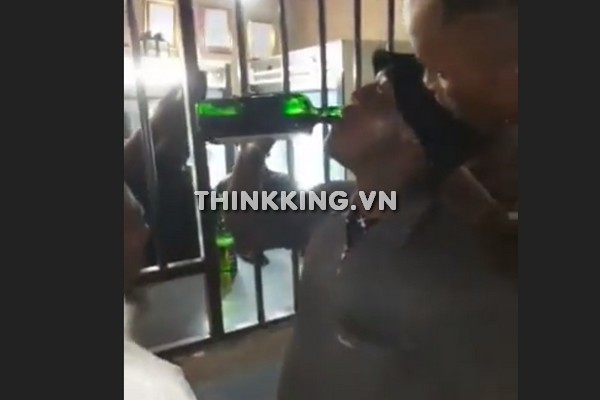Portal Zacarias Menino Da Gasolina: A Child’s Dangerous Bet with Gasoline in Spain

In the vast digital expanse, where the value of a sensational story often eclipses the sanctity of life, a video from the shadows of cyberspace has cast a chilling spotlight on Spain. The “Portal Zacarias Menino Da Gasolina” video is not your everyday viral fare; it is a harrowing testament to the extreme lengths some go for fleeting fame. A young boy, the ‘menino,’ stares down the barrel of mortality by consuming a liter of gasoline, sparking a global outcry and an urgent dialogue on the ethics of digital sensationalism. Spain, now the unwilling stage for this tragedy, confronts the grim reality of viral challenges and their potentially lethal consequences. Siga Kimson.com.vn para obtener más información

I. The Portal Zacarias Phenomenon
In an era where the internet’s appetite for sensationalism knows no bounds, the “Portal Zacarias Menino Bebe 1 Litro De Gasolina” video emerges as a dark spectacle. This disturbing footage, originating from Spain, captures a young boy—referred to as ‘menino’—engaging in a perilous act for online clout: the consumption of a liter of gasoline. The video spread like wildfire, leaving viewers worldwide in a state of shock and disbelief. Its viral nature was not due to its entertainment value but rather the stark illumination of the dangerous interplay between youthful audacity and the grotesque fascination of viral challenges.
The backstory, known as “Portal Zacarias menino da gasolina,” delves deeper into the ‘menino’s’ circumstances leading to the harrowing event. It reflects a broader societal issue where the quest for internet fame can drive individuals to risk their lives. Spain, the unintended epicenter of this viral storm, found itself grappling with the consequences of such a troubling trend, sparking a global conversation about the responsibilities of digital platforms and the audience in content consumption.
The rapid dissemination of “Portal Zacarias 1 litro de gasolina” underscores the potent force of social media dynamics. It demonstrates how quickly dangerous acts can escalate from obscurity to global infamy, raising questions about the ethical implications of sharing and popularizing such content. The incident serves as a wake-up call for a collective reassessment of our digital consumption habits and the need for a more vigilant and protective approach to online content, especially when it can endanger lives.
II. The Gasoline Challenge Detailed

The “Portal do zacarias menino bebendo gasolina” video depicts a harrowing scene: a young boy, driven by an urge for viral fame, recklessly imbibing gasoline. The footage, a stark representation of the lengths to which individuals will go for online recognition, captures a dangerous act that could have been lethal. The ‘menino’s’ misguided valorization of risk for internet notoriety starkly highlights the perilous side of social media challenges, drawing attention to the need for urgent conversations about online behavior and safety.
As the video, dubbed “Portal zacarias bebendo gasolina,” continues, the immediate aftermath is heart-wrenching. The boy, having ingested the toxic fluid, instinctively realizes the gravity of his action and pleads for water—a basic human need that suddenly becomes an antidote to his critical mistake. This moment serves as a chilling reminder of the real dangers behind such online stunts, which often gloss over the potential for irreversible consequences.
The public’s response to the video was swift and emotional. Viewers expressed a range of reactions, from outrage and disgust to deep concern for the ‘menino’s’ wellbeing. The incident provoked widespread condemnation of the so-called “Gasoline Challenge,” leading to discussions about the role of social media platforms in policing content and the responsibility of communities to protect impressionable and vulnerable individuals. The repercussions extended beyond the immediate health risks; the video symbolized a broader societal issue, questioning the integrity and morality of internet culture and the desensitization to dangerous behaviors in the pursuit of online fame.
III. Analyzing the Incident
The “Portal do zacarias menino bebendo gasolina” incident brings to the forefront the dire health and safety consequences of participating in hazardous viral challenges. Ingesting gasoline poses serious risks, including chemical burns to the digestive system, respiratory distress, and potentially fatal poisoning. The video serves as a grim reminder of the physical dangers that can result from such reckless behavior, emphasizing the need for increased awareness and education on the risks associated with these online dares.
However, the implications of the incident extend beyond the immediate physical consequences. The psychological impacts on both the individual performer and the viewers cannot be overlooked. For the ‘menino’, the repercussions may include trauma, guilt, and long-term damage to his mental health, particularly as he grapples with the negative attention and the potential regret of his actions. For the audience, especially impressionable youth, witnessing such acts can normalize risky behavior, potentially leading to emulative conduct.
Preventive measures are critical in addressing the root causes of such phenomena. This includes promoting digital literacy, where individuals, especially young users, are educated on the distinction between harmful content and safe engagement online. Parents, educators, and community leaders play a vital role in this educational process. Additionally, social media platforms are called upon to implement more robust content monitoring systems to prevent the spread of dangerous materials. The collective effort to foster a safer digital environment involves teaching critical thinking regarding online trends, encouraging responsible content sharing, and creating support systems for those who may be vulnerable to the allure of viral challenges.
IV. Public Response and Video Dissemination
The public’s emotional response to the “Portal zacarias bebendo gasolina” video spanned a broad spectrum. Shock, horror, and empathy were among the immediate reactions as the video spread, transcending regional boundaries to spark global awareness. The incident served as a catalyst for dialogue on the perils of online challenges, leading to a collective call for preventative strategies to protect vulnerable populations, particularly children and teenagers, from such dangerous acts.
In the wake of “Portal Zacarias Menino Bebe 1 Litro De Gasolina,” the responsibility of content creators came under intense scrutiny. Content creators wield significant influence in shaping the behaviors and attitudes of their audiences, especially among younger demographics. This incident underscored the ethical obligation of influencers, video producers, and social media personalities to consider the potential consequences of their content. It sparked discussions around the moral imperative for creators to foster content that prioritizes safety and wellbeing over sensationalism and views.
The call to action for a safer digital environment became louder and more urgent post-“Portal zacarias 1 litro de gasolina.” This tragic event highlighted the need for comprehensive strategies to mitigate the risks associated with digital content consumption. Stakeholders, including social media platforms, regulators, educators, and parents, are urged to collaborate in creating and enforcing policies that protect users from harmful content. This involves not only the implementation of advanced content filtering and age restriction measures but also education campaigns aimed at empowering users with the skills needed to navigate the digital landscape safely. The ultimate goal is to cultivate a digital community that values and prioritizes the safety and mental health of its members.
V. Towards a Safer Future
“Portal Zacarias Menino Bebe 1 Litro De Gasolina”: Lessons Learned and Path Forward
The disturbing episode of “Portal Zacarias Menino Bebe 1 Litro De Gasolina” has served as a stark lesson on the dangers of viral internet challenges. The path forward must involve comprehensive education on the potential consequences of such actions. It’s a call for a collective reassessment of social media’s role in shaping behavior, particularly among the youth. Moving towards a safer future requires engagement from various sectors, including tech companies, educators, healthcare professionals, and policymakers, to create a multifaceted approach. This includes promoting online safety, mental health awareness, and developing programs that encourage positive online experiences.
Implementing Stronger Digital Safety Policies in Response to “Portal zacarias menino da gasolina”
In response to the “Portal zacarias menino da gasolina” incident, there’s an evident need for stronger digital safety policies. Social media platforms must enhance their content moderation practices, employing both automated systems and human oversight to quickly identify and restrict hazardous content. Age verification tools can be improved to ensure that young users are shielded from mature content. Additionally, there should be clear and accessible reporting mechanisms for users to flag dangerous activities. The implementation of educational pop-ups when searching for or engaging with high-risk content could also serve as a deterrent.
Collective Responsibility: A Mandate Stemming from “Portal do zacarias menino bebendo gasolina”
The “Portal do zacarias menino bebendo gasolina” incident has reinforced the concept of collective responsibility. Each segment of society has a role to play in creating a safer digital space. Parents and guardians must be proactive in discussing internet safety with their children. Educators can incorporate digital citizenship into their curricula. Peers can support each other in recognizing and resisting the urge to participate in perilous trends. Moreover, individuals and communities must advocate for and support legislation that holds digital platforms accountable for the content they host. Only by working together can we ensure a digital environment that prioritizes the well-being of all its users.
The “Portal Zacarias menino bebe 1 litro de gasolina” video stands as a grim reminder of the dark side of digital notoriety. As Spain reels from the impact of this tragic event, the world watches and ponders the true cost of viral fame. It calls upon us all—creators, consumers, and platforms—to reflect deeply on the content we share and consume. Let this be the catalyst for a global movement towards a more responsible and ethical digital landscape, where the thrill of the ‘like’ never comes at the expense of human life.




